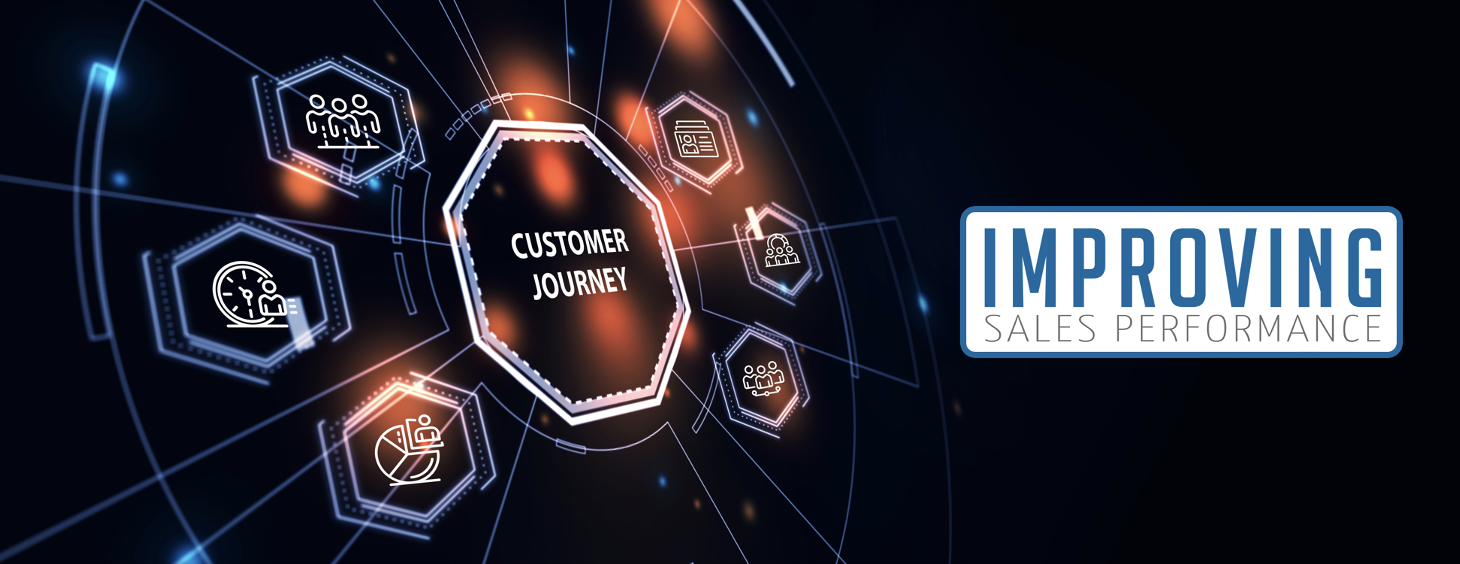|
Most B2B sales (and a good chunk of B2C sales) involve more than the purely transactional. The most successful sales reps understand that developing a relationship with leads is what drives purchase decisions. And a big part of developing that relationship is understanding where the buyer is coming from, what led them to your company in the first place, and why they would ultimately buy from you. This is where a firm grasp of your typical buyer's journey is an invaluable asset. You can generally break it down into five distinct steps. Each one can inform your sales team's messaging, break down barriers, and eventually result in a win. Let's talk about them one at a time. Step #1: The Buyer's Current State This is where you want to paint a picture of your ideal customer persona's daily life, even before they're aware of your company or the solutions you offer. Yes, basic demographics are important here. However, it's helpful to go beneath the surface. Imagine the ups and downs your customer may experience on a regular basis. For example, let's say you provide outsourced software development solutions. Your ideal customer persona is Jonathan, a 35-year-old manager for a software development team. Maybe you envision Jonathan spending most of his time in meetings. He acts as the "glue guy" between different departments within his organization, and deals with a fast-paced workload and a high-pressure environment. This mental image you've created can be a foundation for the next steps in Jonathan's customer journey. Step #2: The Buyer's Challenges It's vital to dig into the specific challenges and pain points your customer is facing. After all, you can't effectively position yourself as a solutions provider if you don't understand the problems that need to be fixed! Think about issues that could keep your buyers up at night, including problems they're already facing and potential problems that they worry about. In B2B settings, think about challenges that could cause buyers to fail at their job, or make their job more stressful and frustrating. In Jonathan's case, perhaps he is concerned about capacity-related questions — e.g., whether his current team has the bandwidth to complete all their deliverables on time. He may find it stressful when one or more of his team members goes on vacation, and everyone else has to pick up the slack. Also, he is very worried about missing deadlines, delivering incomplete product features, or otherwise derailing the project timeline. Step #3: The Buyer's Desired State Now that you've uncovered the customer's key challenges and obstacles, it's time to transition into what a perfect day for them would look like. What would their dream world be, in which all of their problems have been magically solved? Don't be afraid to think big during this step. Remember, though, that before the customer can achieve their ideal state (their wants), they must first address the risks and challenges they're currently facing (their needs). So think about the things that are non-negotiable for their success — their "deal breakers." Then, move on to the things they would like to have, but may not need at the moment. For example, what would Jonathan's perfect world look like? He would manage a team of skilled developers who are creative, able to spot issues quickly, and eager to collaborate with one another. On the other hand, what are his non-negotiable needs? He needs to maintain alignment between team members, achieve business goals, and deliver features and completed products on time. Step #4: The Buyer's Solutions There must be an understanding that your buyer could reach their "happily ever after" through a number of different options. Your solution isn't the only one available. It may be the best solution in certain areas, but includes significant drawbacks in others. Therefore, take a long, hard look at your competition. Think about the distinct benefits and disadvantages that come with their offerings. And don't be afraid to bring those up in your conversations with the lead! Doing so will demonstrate that you can be trusted and that you sincerely want the best for them. Going back to Jonathan's situation, what would some of his potential hiring solutions look like? He could beef up his in-house team with more developers and engineers. He could invest in more training for his current team. Or he could outsource some or all of his team's software development duties. Of course, for each of these solutions there is another subset of options he could evaluate (like whether to outsource to a domestic or offshore company). Step #5: The Buyer's Purchase Finally, we come to the step in which your sales reps will (hopefully) close the deal. It's important to note that not all leads (even warm leads) are immediately ready for this step. However, when your reps understand the previous four steps of the buyer's journey and use them to inform their talking points, they'll be in a much better position to convince and convert. A large part of this step is "de-risking" the purchase for your lead. In other words, bolster the customer's confidence in your solution. Provide case studies, testimonials, references, and warranties as needed. Make sure you understand what process your B2B customer needs to go through in order to finally pull the trigger. Lastly, make sure your customer understands any final actions they need to take to buy your product. After reviewing several options, Jonathan may decide to outsource some of his software development workload to your company. Perhaps he is impressed with testimonials from your other clients. Or (after talking with one of your reps) realizes that outsourcing is actually less costly than hiring new in-house developers, and provides more scalability. He is also reassured by your company's vetting process for developers and feels confident that they have the skills and experience needed to make his projects a success. If you carefully examine each step in this five-step buyer's journey and disseminate that information to your sales team, then your reps will be in a prime position to develop strong relationships with leads, overcome objections, and close deals. Learn More A healthy relationship between sales and marketing is vital to an organization’s success. Dive deep into this effective strategy in a new book called Sales & Marketing Alignment. If you'd like more insights on how you can improve your sales leadership, contact us. Or sign up for our newsletter for more valuable resources.  Do you know exactly who your ideal customer is? Have you developed accurate customer personas? Many company leaders may say something like: "Of course we do! We sell to tech companies." But do they understand which people have a stake in the decision-making process at one of those tech company clients? Who actually makes the final decision? As you can tell from this simple example, staying at the surface level of who a customer is inevitably results in knowledge gaps for marketers and salespeople alike. Perhaps just as bad is when everyone on an integrated team has completely different ideas about what their target consumer looks like. (For instance, are "tech companies" SaaS companies or IT service providers... or both?) Without having clearly defined and detailed customer personas to help you focus your efforts, misalignment is all but guaranteed. Put another way: you may reach out to the wrong people, with the wrong messaging, while promoting the wrong product. On the other hand, when you have that clear-cut customer persona in front of you, everyone on your team will be in a much better position to succeed. Your sales reps will understand how and why your customers interact with your brand. Plus, they may even be able to answer customer questions before they ask them. And your marketers will be able to craft highly targeted and compelling content — content that generates conversions. The Groundwork for Creating a Hyper-Specific Customer Persona There is a basic three-step system that will help you narrow down which customers you should pursue in the first place. Here is what it involves:
Why Flexibility Is Key At times, your ideal buyer may need something you didn't foresee. Even if the discovery initially catches you off-guard, once you have that information in hand, you can use it to pivot your strategy and create more effective marketing materials and sales pitches. Keep a close eye on how your marketing campaigns perform after you've created a new customer persona. Are you generating as many leads as expected? Are those leads converting, or is there a bottleneck somewhere in the sales funnel? Don't be afraid to go back to the drawing board if it's obvious that your messaging or offering doesn't align with customer needs. You may be selling to the wrong people, or may just need to tweak your offering to resolve a more specific problem than you'd anticipated. Of course, communication between your sales and marketing teams is absolutely imperative if you want to maintain your flexibility. Be especially sensitive to the risk points that leads may express concern over — your ability to sell your offerings to them depends on your ability to address those risks. Paint a Detailed Picture of Your Customer Personas When you begin to develop customer personas, you want to make it as realistic and detailed as possible, even to the point of choosing a stock photo to go along with the fictional name you've selected. A good starting point may be thinking about one of your current customers who fits the mold of an ideal buyer. Perhaps you can ask your sales team about them, or even interview them personally. Then, you'll be able to leverage your knowledge of that customer, along with some historical data, to create a persona that effectively mirrors real life. Spend some time imagining your customer persona's profile and general characteristics. As you develop the persona, drill down as far as you can go in terms of personal demographics. For instance, you may want to think about distinctive elements like:
Of course, there's no need to go overboard with your customer persona: you're a salesperson, not a Russian novelist! Still, the more relatable you make it, the easier it will be for your sales and marketing team to identify with and adapt to your target consumer. It certainly takes some effort to identify and define your ideal buyer. But at the end of the day, doing so is a major step toward improving your company's sales performance and forging long-lasting, mutually beneficial relationships. Learn More A healthy relationship between sales and marketing is vital to an organization’s success. Dive deep into this effective strategy in a new book called Sales & Marketing Alignment. If you'd like more insights on how you can improve your sales leadership, contact us. Or sign up for our newsletter for more valuable resources.  Are you using the Revenue Equation? First, let's cover why it's important. In order for any sales and marketing tactic to work at maximum effectiveness, it must be implemented within the context of an overarching strategy. Simply put, you need to determine where your business is right now and where you want it to go. Then, develop a plan to get from point A to point B. That's your strategy. Many sales and marketing teams pull the trigger on key decisions without having a clearly defined strategy in place. On the other hand, the most successful companies out there adhere to their core strategy in all major sales and marketing decisions. They have a firm grasp of what their sales strengths and weaknesses are and deploy their tactics accordingly. At the end of the day, your company's strategy will determine the ultimate success of your sales and marketing efforts... which in turn will determine whether you hit your revenue and profitability goals. Thus, the ability to identify strengths, weaknesses, areas of misalignment, and adjustments that are "low-hanging fruit" is vital to sustainable success in your sales and marketing integration journey. You may wonder: Okay, I understand all that, but how can I effectively identify those things and then make the needed changes? This is where an exceptional tool comes into the picture: namely, the Revenue Equation. Why the Revenue Equation Is So Powerful The Revenue Equation is a framework for sales and marketing organizations. It's an assessment designed to help understand the root causes of sales and marketing problems. Ultimately, the goal is to create systems that will solve those problems. The true power of the Revenue Equation kicks in when all the stakeholders in an organization (specifically, leadership, management, and sales/marketing team members) get on the same page. When everyone in a company has a clear, shared understanding of what needs to happen moving forward, then everyone can work as a team to turn that vision into a reality. I talk more about the Revenue Equation in this recent audio interview. How the Revenue Equation Works The Revenue Equation consists of three core factors that paint a comprehensive picture of what's needed for revenue stabilization and growth. These three factors are:
For each factor, you'll need to assess where your company stands at the moment, especially in comparison to where you want it to stand. Everyone in your company should take part in this assessment. Remember: you want all stakeholders to be on the same page. With that in mind, let's briefly list some questions that your assessment should include, taking it one factor at a time: 1. Foundations How well defined and understood within your organization are:
2. Design How well defined and used within your organization are:
3. Infrastructure How well defined and used within your organization are:
As you implement the above assessment throughout your company, you may indeed find several areas of opportunity that need to be addressed. However, don't forget about the flip side of the coin: you'll no doubt also identify several sales strengths that your organization possesses — advantages that your competitors may not have. So the Revenue Equation is not only a great way to identify bottlenecks in your sales and marketing process that is hindering progress; it's also a wonderful way to remind yourself of and solidify those aspects of sales and marketing that your team already does really well! How the Revenue Equation Can Lead to Strategic Success It should be noted that the Revenue Equation is not a "one and done" type deal. It can (and should) be refined and redeployed over the course of time, as your company grows and adapts to new opportunities in the market. Leveraging the Revenue Equation in such an intentional way can create accountability, increase efficiency, and optimize performance throughout your organization. It will help your sales and marketing teams become (or stay) aligned, and develop greater clarity around their role in propelling your business forward. Let's briefly review what you can do to leverage the Revenue Equation into a sustainable growth driver:
It's true that investing in strategic development can be time-consuming at first, and it may be tempting to "skip ahead" to sales and marketing tactics. However, using the Revenue Equation discussed above can lay a solid foundation for all of your future sales and marketing efforts. It can help align all departments within your organization and ultimately improve your sales performance. Ultimately, it will increase sales! Learn More A healthy relationship between sales and marketing is vital to an organization’s success. Dive deep into this effective strategy in a new book called Sales & Marketing Alignment. If you'd like more insights on how you can improve your sales leadership, contact us. Or sign up for our newsletter for more valuable resources.  It's been said that "the most reliable way to predict the future is to create it." We could apply that to countless aspects of life. But let's focus on improving sales performance for the moment with a vital sales success tip. Wouldn't it be nice if you could not only visualize the ideal outcome for an upcoming sales meeting, client call, or coaching session, but actually work backwards to trace the steps needed to make that outcome a reality? Well, the good news is: You can. And all it takes is a relatively straightforward exercise we call the "look back." What Is the "Look Back" Exercise? The "look back" exercise has been called different things by people in different fields. For instance, in chess it's known as "retrograde analysis." Others refer to it as "inversion," or "backtracing." Whatever you want to call it, the point of the exercise is, first of all, to see yourself in the future. Visualize yourself in the event or experience that you are planning. Then, work backwards from that future point to make sure the "current" you positions yourself for success when the time arrives. "Look back" exercises enable participants to clearly identify what they need to do in the present to prepare for future wins. As an added bonus, you can do your "look back" with your sales team, or by yourself! In fact, it may be helpful to train your team on the basics of this exercise. Try it during your next sales meeting! Then, encourage each one to use it as a self-coaching tool. Why Is It important? The "look back" exercise is a critical sales success tip because it helps you connect the present with the future in a coherent, intentional way. It can remind you that a successful outcome several weeks down the road is really the result of progressive, deliberate actions taken today, tomorrow, and each day thereafter. Put another way, a "look back" session helps you to develop a workable game plan for creating the future you want. How Does It Work? In the context of sales, a "look back" exercise can be used in several ways. Again, it is inseparably connected with visualization. You're seeing the best version of your future self in that meeting, in that coaching session, or on that sales call. So the two big questions that you must answer within an effective "look back" exercise are:
As you can tell, "look back" exercises can get very deep, very fast. In the sales industry, here are two common real-world scenarios in which a "look back" may prove extremely beneficial: 1. Sales managers preparing for team meetings. If you're a sales manager preparing for an upcoming team meeting, there are a ton of different factors to consider during your "look back" session besides the basic meeting agenda. For one thing, you want to give attention to how your team members perceive you. Do you want to be seen as a coach? Are you someone who is really understanding and approachable? What outcomes would you like to see? Upon reflection, you may see the need to spend more time with certain team members in the present, so as to get them in the right mindset when the meeting day arrives. 2. Sales reps preparing for client meetings. Conducting a personal "look back" exercise can be a great preparation tool for any sales rep with a big client meeting on the horizon. Think about the kind of experience you want the client to enjoy. Do you want to position yourself as a fun, engaging guide who's ready to contribute to the client's success? Will you be able to back up your proposed solutions with hard data? What would success look like for the client? Now is the best time to anticipate questions and concerns that may come up during the conference. As a result, you can outline effective ways to address each one. And if you find yourself hitting a wall, it may be a good idea to bounce your ideas off your coach. You could even do a "practice run" ahead of time. Who Should Use "Look Back" Exercises? The short answer? Anyone who wants to be a change agent and create high-impact meetings. Of course, in the sales world this definitely includes team managers who want to achieve optimal outcomes from their meetings. It also includes customer-facing reps who want to take advantage of each interaction with prospects to help them progress through the sales funnel. "Look back" exercises can be performed on an individual basis, or as a group. In either scenario, they are great ways to create intentionality by focusing on the desired outcome, and then mapping back to the present to start taking the required steps. It can be all too easy to go through professional life hopeful of positive outcomes. However, we're often unsure of how to influence them. "Look back" exercises are invaluable because they cut through much of the uncertainty. Use a "look back" in preparation for your next meeting. As a result, you're proactively thinking about what you can do in the present moment to make the future moment a success. In other words: You're doing more than just predicting the future. You're creating it. And when it comes to improving sales performance, either individually or as a team, it's hard to top that! If you'd like more insights on how you can improve your sales leadership, contact us. Or sign up for our newsletter for more valuable resources.  Is your entire sales process built around "solution selling?" Or do you solution sell at least part of the time? If so, then it's important to demonstrate to your prospect that you can create real value for them. Show you're committed to finding not just a solution, but the best possible solution to their problem. One great tactic that can help you take your solution selling to the next level is called the "trial balloon." Let's talk about how this simple, proven construct can really propel your conversations forward, and aid in your value-creation proposition. What is the Trial Balloon Strategy? The term "trial balloon" originated during the 1700s. The Montgolfiere brothers in France were striving to create a working hot-air balloon. Obviously, they didn't want to risk life and limb by taking off in a hot-air balloon without some assurance that it would actually stay aloft! Thus, they sent up trial balloons to test their design before finally committing to a journey of their own. In marketing terms, the basic concept is the same. The trial balloon strategy is a technique in which you put an idea "up in the atmosphere," and see what your prospect thinks about it. Most prospects don't want to quickly commit to a contract or agreement unless they first have some assurance that they'll get real value in return. As you "float" ideas to them, and they see the value in your ideas, their trust in you will gradually grow. This process gradually gets you much closer to a final sale. How Does It Work for Solution Selling? It's important to realize that sending up a "trial balloon" for your prospect may require some quick pivoting on your end. After all, if your prospect isn't enthusiastic about one idea, then it's vital that you transition to another idea before they lose interest completely. (This is why you should always have multiple ideas in your arsenal, especially in the initial stages of your relationship with the client.) So how exactly does the trial balloon technique work? Here's one possibility: Imagine you're talking to a new prospect named Rick. He's already told you about the main pain points he wants to address. You could say something like: "Thank you for sharing your situation with me. I really appreciate your straightforwardness. I do want to create some value for you, and I have some ideas. So what I'd like to do is get my team together, sit down with you, and share these ideas before we finalize a proposal. I just want to make sure that I'm on the same wavelength as you. Would that be okay?" Nine times out of 10, Rick is going to say "yes" to your suggestion. Then, after you and your team have strategized on which ideas to present, you can share those with him. Trial balloon ideas are like rungs on a ladder that ultimately lead to a sale — the more ideas Rick likes, the easier it will be for you to provide him with a customized solution to his problem. Each step increases the possibility that he'll do business with your company. Watch me explain this concept in this video tutorial. Trial Balloons Work at Every Stage in the Buyer's Journey The great thing about trial balloons is that they work all the time! Whether you're dealing with a current client, or with someone who's just entered your funnel, you can always use this technique to get a pulse on where they are, and what they're looking for. A "trial balloon" strategy should be part of your consultative selling toolbox. If you make good use of this technique, you'll almost certainly see your sales performance improve dramatically. If you'd like more insights on how you can improve your sales leadership, contact us. Or sign up for our newsletter for more valuable resources.  If your sales team is having alignment issues, one of the first places you need to look is at your sales foundations. You can't build a long-lasting house without a solid foundation. The same is true of sales success. You can't generate sustainable growth without first identifying and solidifying your company's sales foundations. What are Sales Foundations? Sales Foundations revolve around core elements of your business. What is your company all about? What does it have to offer? How is it different from the competition? For instance, your sales foundations will typically include:
Of course, you don't want to arbitrarily define your sales foundations without any feedback from your key stakeholders. At the same time, you don't want each of your sales reps to guess at what those foundations are, either. Instead, you want everyone to agree on what those foundations actually are, and really buy into them as the starting point for growth. How Sales Success is Optimized At this point, you may be wondering: "Why would I really need to define my company's sales foundations? As long as our reps are doing their jobs, does it really matter whether they're onboard or not?" There's no denying that your team can earn some wins, big and small, without having clearly defined foundations for your sales process. The problem is, without those sales foundations in place, you'll never be able to make those wins systematic. Sales success will be left to chance. For instance, take a sales rep who closes a huge deal with one of your accounts. You're elated! You want to use the rep's experience as training for the rest of your team. But then you realize: You don't really know why the rep was successful. In fact, the rep can't figure it out, either! Here are just a few of the questions that might come up:
You see, things can get real confusing, real fast when you don't have firmly established sales foundations to lean on. Without defining what made sales success possible, it's difficult to repeat that success. On the other hand, when you do have those sales foundations in place, then you'll know exactly why your reps are successful - or at least which areas they can improve in. Your well-defined foundations enable you to build a clear framework for your sales process, and make major wins repeatable, instead of one-off occurrences. Create a Cohesive Identity Bottom line? When you define your sales foundations, you give your team a cohesive identity that they can tap into for each customer interaction. And when you know exactly who you are and what you have to offer, it's much easier to win over the customers that you want for your business. Gain more insights and effective sales leadership techniques for your SMB by signing up for our newsletter. Contact us directly, or explore our website for other valuable resources and webinars.  One of the biggest roadblocks to improving your organization's sales performance is when the decision makers are not in alignment. Think of it like a road trip. If everyone in your family is on the same page about your destination (say, Denver to LA), then it's okay to have a little "back and forth." Which route should we take take? Which attractions do we want to see along the way? But if half of your family wants to go to LA and the other half to Seattle, then you really only have three options:
In the same way, if the decision makers at your company have completely different "destinations" in mind for the business (i.e. different goals, visions, or missions), then one side will have to come around to the other side's way of thinking. Otherwise, your company will stagnate or (gulp) split apart. The bottom line? Your decision makers absolutely must be aligned if positive change is to be affected. What it Looks Like When Decision Makers Aren't Aligned Misalignment among decision makers can manifest with several symptoms. Here are just a few of the trouble signs to look for.
Obviously, this is not a comprehensive list. But it paints a picture of what misalignment can look like. When decision makers are not aligned, the change process can become slow and frustrating. It gets bogged down in arguments, or even evolves into a power struggle. How to Get Your Decision Makers on the Same Page Clearly, you have to get your decision makers on the same page before bringing other team members into the change process. Let's talk about three ways to encourage unity of purpose and action within your company. 1. Create a Consensus If decision makers have different ideas about which direction the business should take, your first step towards alignment should be to develop consensus among the leadership team. Here's one important exercise that can help. Have all of your company's leaders sit down and write their individual answers to the following questions.
The point of this exercise isn't to quiz your decision makers. There is more than one correct answer for each question. In fact, everyone may give different answers — and that's okay! Your goal here is to create a common starting point. Once each decision maker understands where the others are coming from, you can generate a discussion about how to synthesize all those answers into a workable strategy that everyone can agree on. 2. Develop Clear Boundaries for Leadership Misalignment often occurs when there is confusion about who exactly should give the "final word" on implementing changes within the organization. Take two common examples:
If there's a lack of clarity on who makes final decisions for the company, then any proposed changes can easily fall to the wayside. That's why it's so important for the change agent to clearly define who is in charge, and then hold them accountable for their authority. When clear boundaries are set, progress can be made. 3. Balance Flexibility with Decisiveness Good leaders are flexible and responsive to suggestions — no doubt about it. However, that strength can easily become a weakness in the form of indecisiveness. For instance, a leader who's willing to share some of his power with others may hesitate to "pull the trigger" on a proposed plan of action without approval from all of his subordinates. While flexibility is good, decisiveness is also essential. The person who makes the final decision on any initiative for change must be the same person who keeps his/her leadership team focused on the ultimate objective - and also supports the change agent's efforts to do so. With a strong, decisive leader at the head of the improvement effort, needed changes can be made in a timely manner. Decision makers who place an emphasis on collaboration can bring a lot of value to the company — especially if they know when it's time to listen, and when it's time to act. Define the "Where" and the "How" and "When" Will Follow If you implement these three suggestions, you'll likely be able to get all of your decision makers on the same page. Once everyone has that same destination in mind (the where of your company), it becomes much easier to negotiate the how and when of getting there. Gain more insights and effective sales leadership techniques for your SMB by signing up for our newsletter. Contact us directly, or explore our website for other valuable resources and webinars.  Things are changing fast in the world of sales. One of the most significant changes brought about by the pandemic is the transition from in-person visits to virtual client sales meetings. Whether you handle your sales calls by phone or video conference, connecting with your customer in the same way that you did with in-person meetings is vital. It is possible to build that same sense of excitement and personalized care in a virtual client sales meeting. Using new methods and simple techniques, you can create the same productive atmosphere. In fact, it's often the simple things that make the biggest difference. Try these practical tips to maintain a personal connection during virtual client sales meetings. 1. Prepare Yourself You wouldn't attend an in-person sales meeting without reviewing the customer's account and customizing your product/service offerings just for them. Maintain the same level of preparation for virtual client sales meetings. That includes reviewing personal notes. What do you know about their family, business history or any other general personal interest topics? Preparation also includes your tech tools. Don't assume your client knows how to use these tools. Not everyone has experience with Zoom or other forms of software. You would not want to make your customer feel inadequate. Give them the option of phone or video conference. Here's a list of top tech challenges I've noticed when scheduling virtual meetings. Review these, and be proactive about giving your clients a heads-up about potential challenges. The bottom line is, take the same amount of care in preparing for a virtual meeting as you would an in-person one. 2. Prepare Your Team If you're a sales manager, it's up to you to set your team up for success. Ensure they have the right tools to engage with clients online or over the phone. Do your reps have effective apps, laptops, tablets, Bluetooth devices, and most importantly, a solid internet connection? Do they have a tech resource if they need support for any of these tools? Don't forget the training! Some of your team members might not have used a video conferencing app before. Show them how powerful these tools can be. Provide training regarding both the technical aspects and basic etiquette. Also, remember that tools are not always tangible things. Tools also include support, such as role-playing sessions with managers or other team members, or brainstorming meetings to discuss specific techniques for unique clients. 3. Limit Distractions Yes, you have seen the viral videos of the cat interrupting an online meeting or someone's kid running through a screenshot. They make for funny YouTube clips, but you don't want those types of distractions when you're trying to duplicate the professional feel of an in-person meeting. Before your virtual client sales meeting begins, devise a way to block your meeting area from pets and ensure your kids understand the importance of not interrupting your meeting. It's essential that you focus on your meeting and minimize any possible distractions ahead of time. Turn off your mobile devices and other digital notifications to ensure your client feels like they have your undivided attention. 4. Break the Ice In the past, there was always a time at the beginning of the meeting when you broke the ice — a few minutes of casual conversation to get to know each other better and establish trust. Don't bypass this step just because the sales meeting is virtual. When you learn more about your customer's personal life, you can determine how it's affecting their business one. Ask about their family. Where are they from? How did they get into this business? Balance nosey with showing personal interest. 5. Be Aware of Your Background When you're having a virtual client sales meeting from your home, you may be showing your audience more than you want to. Before any online meetings, determine how much of your home and space the client can see. Clean and organize the space to give it a professional look. You don't want your client distracted by a stack of dirty dishes or a trophy from third grade. Consider choosing a room with a plain wall and placing your computer in front of it. Access More Resources Engaging your clients during virtual meetings is just one challenge to our new work dynamic. Keeping your sales team engaged while they work remotely is another hurdle. I just addressed that topic in this recent blog. Gain more insights on how to improve sales performance for your SMB, sign up for our newsletter. Contact us directly, or explore our website for other valuable resources and webinars.  In 2020, the Covid-19 pandemic played a key role in workers leaving the office and working from home. According to Forbes, 74 percent of employers believe that working remotely is the future. Even more shocking, 97 percent of employees have no desire to return to the office full-time. However, working remotely can be a challenge for sales teams, groups designed to thrive on each other's momentum. "Iron sharpens iron" is a proverb that definitely applies to sales reps. How can sales managers ensure their team will thrive in this new work environment? It's essential that you set your team up for success. Here are five ways to keep them connected, productive, and competitive while working remotely. 1. Nurture Your Team's Competitive Nature It is harder to foster a sense of competition in your sales team when each member is at home alone. However, salespeople are competitive by nature and need that dose of healthy competition to stay motivated. Get creative and find new ways to maintain momentum and recognize each person's successes. Single-out top performers in a team email, group chat, or during a weekly video conference. Consider celebrating each sale. This type of nurturing will make each of your team members strive harder to receive their own recognition. Read more about why ringing the figurative bell is critical to motivating your team and tips on how to do it effectively in this recent blog. 2. Provide the Right Tools for Working Remotely It's up to you to set your team up for success, and that means the right tools to get the job done. From laptops and tablets to apps and security programs, your team needs access to tools to continue selling from home. Not all the tools you offer your employees are tangible items, though. "Tools" also include access to coaching, managerial support, brainstorming sessions with other reps, and interaction through video chat. Create an open-door policy. Ensure your team feels comfortable coming to you when they need something to be more effective at their jobs, whether it's a tangible item or a listening ear. 3. Continue Training and Learning New Skills Training is a big motivator to go out and try new things in your sales routine. When your team works remotely, it's easier to let training slip off the schedule. It's essential that you continue training your staff and introducing new methods of making sales. Schedule training on a weekly or monthly basis during an online meeting. If you've had a member of your team experience success with a new technique, consider asking them to lead a training class on it. This builds goodwill and helps your team learn new selling methods. Many well-known sales training courses have shifted to a virtual environment. Offering formal training demonstrates an investment in your team. Identify training that your team would benefit the most from. 4. Define Your Expectations and Goals When you're in an office setting, it's easy to create a visual system that shows the team's goals and their current progress. Keep this trend going in the virtual environment. Define goals and how the team performed during the previous period at sales meetings. Many managers prefer to schedule a quick meeting early each week to build momentum and encourage the team to get tasks accomplished and sales closed. 5. Create a Water Cooler When you have a sales team that works in an office together, they have time to bond and learn to trust each other. They do this through basic socialization. The team discusses sports, family, hobbies, and other topics. In the past, you see this kind of talk going on around the water cooler, in the break room, or just in the hallway. Create a space for your team of remote workers to have this type of social interaction. There are a variety of apps that you can use to accomplish this. Slack, one of the most popular platforms, reports 12 million daily active users and 156,000 subscriber organizations. You could also hold a team lunch once a month. If in-person is not possible, meet online and share a meal. Help Your Team Flourish Keeping your remote sales team engaged is essential to its success. With a little planning and encouragement, your team will flourish. If you'd like more insights on how to improve sales performance for your SMB, sign up for our newsletter. Contact us directly, or explore our website for other valuable resources and webinars.  There's a quote from one writer that goes like this: "Don't chase success. Decide to make a difference and success will find you." Even though that concept could be applied to many aspects of life, let's look at it from the viewpoint of sales success in your organization. It's true that everyone in the sales industry wants that "big win," that easy fix to their performance issues that makes everything fall neatly into place. There's nothing wrong with that feeling. It's only natural. Here's the thing, though. Chasing that big win is usually counterproductive. In real life, it almost always takes a series of small, deliberate actions to get to a place where your business is humming along. It takes cooperation and collaboration. It takes hard work and perseverance. It takes intentionality and planning. Here's another saying (or part of a saying) that makes the point well: Your actions become your habits. Your habits become your values. Your values become your destiny. What Sales Success Stories Have in Common The point is, business growth is the result of small, intentional actions and good habits. These form the foundation of your brand's values and reputation. And ultimately, they decide your organization's destiny. Sales success stories may be flashy, or dramatic, or even heartwarming. But if you dig a little deeper, you'll almost always find that all success stories have a few things in common: namely, 3 solid frameworks that enable a sales organization to perform at a high level. Let's talk about each one of these frameworks, and why they are so crucial to improved sales performance. Framework #1: The Revenue Equation The Revenue Equation framework is actually a combination of three critical factors that form the basis of your entire sales process. These three factors are:
When each of these factors are streamlined and optimized, the result will be revenue stabilization and growth. The question is, what do these elements involve, and how do they work together? Sales Foundations (Who Are You?) Your sales foundations are the values and characteristics that make your brand unique. Sales foundations include your company's reputation, your pricing strategy, and your unique selling proposition (USP). Think of Apple, Inc. as an example. They have a reputation as a leader in technological innovation. Their price points reflect their position as a premier brand, and one of their USPs is their commitment to personal privacy and security. As the name implies, your sales foundations form the basis of everything else you do within the sales process. That's why you absolutely must understand who you are as a company, and then play to those strengths. Sales Design (Who Do You Sell To?) Once your sales foundations have been firmly established, you need to understand who your target customers are. After all, you don't want to be "punching air" by targeting consumers that aren't likely to purchase from your business. This is where buyer personas come into the picture. Your marketing team (preferably with input from sales) needs to come up with a profile of your ideal customer — or even multiple profiles, depending on how specific your targeting is. With that buyer persona in hand, your sales reps will be in a better position to understand the thoughts, concerns, and desires of their leads, nurture them effectively, and eventually convert them into paying customers. Sales Infrastructure (How Will You Sell It?) Once you have a firm grasp on who you are, and who your ideal customer is, it's time to build your sales infrastructure. In other words, the processes that can bridge the gap between you and your consumers. Your infrastructure includes the systems and software programs you use to manage customer relationships, your clearly defined sales funnel, as well as your KPIs, metrics and quotas. When these three elements — sales foundations, sales design, and sales infrastructure — are all working properly, and are clearly aligned with one another, then your first framework (The Revenue Equation) is firmly in place. Framework #2: The Individual Performance Planner Your Revenue Equation is in place. Everyone on your team has collaborated to make it a reality. Now, you have to start shifting your focus from the big picture to the details. These details are comprehensive, from the Revenue Equation to the individual performance of your sales reps. This is where collaboration and open communication become even more critical. Within this framework, your first order of business is to discuss with each sales rep what his or her strengths and growth opportunities are. What short-term and long-term goals will the rep set inside (and possibly outside) of work? The outcome of these discussions will be condensed and solidified into their own Individual Performance Planner. Intentionality is key in this framework. You have to demonstrate how serious you are when it comes to supporting your team members, and helping them achieve their goals. At the same time, your reps have to buy into this process, and commit to being the best salespeople they can be. This give and take is the only way to achieve maximum value from the important (but still theoretical) Revenue Equation. Framework #3: The Revenue Planner This final framework is where you'll see the fruits of your labor. You have your Revenue Equation in place, and your team members onboard. Now you have the insights and the freedom to identify key growth opportunities within the sales process. Next, you'll develop a plan of action for each one. Over the first three months of the process, this will involve taking various actions. Consider adjusting discounts to featured products, doubling down on relationships with established customers, or refining your price points. Really, the sky's the limit. After achieving some quick wins, you'll want to stabilize your revenue in the following three months. Aim for continuous revenue growth in the months (and years) to follow. While the Revenue Planning stage is unique to each business, the framework it provides is useful across the board. Create Your Own Success Story Look deeply at sales success stories. Odds are you'll discern these three frameworks at work, in one way or another. Build your sales process around these frameworks. Then, your company will also enjoy quick wins and sustainable growth. If you'd like more insights on how to improve sales performance for your SMB, sign up for our newsletter. Contact us directly, or explore our website for other valuable resources and webinars.  The sales industry often revolves around meeting metrics, making quotas, boosting the bottom line, and finding the latest top sales tip. It's a "production mindset" that has been ingrained within many salespeople for years and years. So it only makes sense that when an organization's sales process isn't working properly, management's instinctive reaction is, more often than not, to look for a quick fix — e.g., the proverbial "miracle cure." If only it were that simple. The Myth of the Miracle Cure The reality is, very rarely can all of a company's growth-related problems be traced back to a single cause. Businesses have many moving parts. They are made up of many individual actors. Because of that complexity, the notion that "all of our problems can be fixed if we address this one issue" is typically exposed as faulty reasoning (sooner or later). Let's talk about a common scenario. Many organizations blame their sales problems on a lack of quality leads. That seems reasonable, right? If there aren't enough good leads coming in, then how can you expect to grow a business? As a result, these companies may try out new CRM systems, add extra incentives for reps that make their quotas, or look for that magic sales tip from an outside consultant. All of those actions are good. They will likely provide some benefits. But... what if the problem isn't really the number of leads? Why It Doesn't Work Imagine that Company X does what it takes to bring in more leads for their sales reps. To them, that's the "miracle cure" that will solve of all their problems. However, after several months their revenues haven't really increased. Why isn't the quick fix working? It could be any number of reasons. For instance:
What's the point of all this? Simply put, don't look for a quick fix. It's better to take a step back and probe for deep-seated issues that need to be addressed in order to move forward. Oversimplification = Underperformance It can be tempting to boil down all of a business' sales issues to one cause. After all, popular culture teaches us that if people can just fix that one, fatal flaw (Achilles' heel, Darth Vader's anger, Hamlet's indecision), then everything will be smooth sailing. The truth, of course, is usually far more complicated. The myth of the miracle cure has its roots in oversimplification. But let's not kid ourselves: It takes a lot more time and effort to address underlying performance issues than throwing money at a "quick fix" solution and hoping that things work out. Here's the key takeaway. Don't oversimplify your sales problems. Be willing to put in the work of analysis and research. Take time to figure out all the factors that could be contributing to your team's underperformance. Don't be quick to point the finger at any one thing, person, or department. Seek an outside perspective, if you need it. If you avoid the trap of the "miracle cure," then you'll be in a much better position to identify and address performance issues — and your business will benefit as a result. Get Actionable Sales Tips If you'd like more insights and sales tips on how to improve sales performance for your SMB, be sure to sign up for our newsletter, contact us directly, or explore our website for valuable resources and webinars. How would you respond if someone asked you: "What's the main job of a sales manager?" Would you talk about pushing your team to meet quotas? Improving productivity metrics? Driving better performance?
Granted, when we're talking about any position in sales we can't discount the importance of the bottom line. But there's a right way and a wrong way to achieve the results you desire. The right way is to bring out the best in your team. That means supporting each individual member, mentoring him or her, and (at the same time) building a certain level of predictability into your forecasting model. Use KPIs to Build Visibility into Your Sales Funnel If you really want to drive team performance as a sales manager and motivate your individual employees to give their best work, then creating more visibility into the sales funnel should be one of your top priorities. The truth is, sales reps thrive within clear boundaries. When you and your team know which Key Performance Indicators (KPI) are most important to sustained, lasting success — and why they're so important — then everyone can work together to meet the same goals. That's one critical way you can support your team. To paraphrase Tom Petty: You don't want your people to be "out in the great wide open," sales reps without a clue. So now the question becomes: Which KPIs should you focus on? There are a ton of crucial metrics in the world of sales, but let's narrow our discussion down to three big ones:
Let's take these one at a time, and see why they're so important to individual and team performance. 1. Sales Funnel Populations It goes without saying that your organization needs to have a sales funnel with clearly defined stages. After all, your "sales pipeline" becomes much more predictable within such a structured framework. If it's predictable, it's measurable. And if it's measurable, it's improvable. Once you have your sales funnel stages clearly defined (and your sales and marketing departments on the same page), you need to determine three things.
Why are these sales population KPIs so important? For one thing, they're great markers for the overall "health" of your sales funnel. If you see increasing populations, then you can expect revenue growth. If you notice decreasing populations, then you should brace yourself for revenue contraction in the near future. These metrics also provide actionable insights. For instance, they can help your finance team forecast for future demand. They can shed light on which activities are driving growth, and which ones are ineffective. Moreover, they can provide a wonderful point of reference to which you, as sales manager, can align your teams for more stable, quantifiable growth. 2. Conversion Rates We're specifically talking about conversion rates between funnel stages here. There are two key elements in play: the amount of time it takes to move leads from one stage to another, and the quantity of leads that make the conversion. What are good benchmarks for your company? It really depends on your specific business and industry. However, if your percentage of leads moving from the evaluation stage (middle of funnel) to the decision stage (bottom of funnel) is low, or if it's taking those leads a long time to convert, then you'll need to make some adjustments. Why are these two aspects of your intra-funnel conversion rate so important? Basically, for three reasons.
3. Close Rates Finally, it's vital to understand your team's average close rate (aka "quote to close ratio," "lead-to-customer conversion rate," etc.) — both as a whole, and for each individual member. Not only does the close rate help to calculate ROI, but it also provides a baseline from which to manage your sales team. Why are close rates so important for sales managers? Realistically, not everyone on your team is going to be a "sales superstar." But knowing the average close rate for your team can inform your expectations for new team members. In addition, knowing the close rates for individual members can provide a great starting point for your coaching/feedback sessions. This knowledge will also act as an early warning sign if someone needs extra support (for example, if a high performer's rate starts to drop month over month). Your close rates can help you to inject a heavy dose of predictability and transparency into your sales process. They can help you set lofty but reasonable goals for each sales rep, incentivize improved performance, and forecast growth. Leveraging KPIs for Sustained Success There you have it: three important KPIs that every sales manager must use! If you take away one key point from the above information, let it be this: Use your KPIs to create visibility, predictability, and accountability for your sales team — and yourself. When your team members have clear, actionable direction and specific goals to shoot for, they'll not only be more productive — they'll be happier at their job. They'll be able to individually improve themselves. At the same time, you'll be in a better position to mentor and support them on a one-on-one basis. Sales KPIs, when used properly, can be a dashboard for performance, both in terms of revenue and human capital. That's their true power. Don't take it for granted! Of course, there's a lot more to the world of sales management than the three metrics discussed above. If you'd like to chew on some more practical SMB insights and advice, sign up for our newsletter; contact our team; or check out our website for valuable resources and webinars. We'd be happy to help you grow your business, one KPI at a time. Marketing and sales is all about communication. Even if you have an experienced sales team, aligning them with effective marketing strategies that will drive profits can be difficult. Help these two camps work together productively by gaining better insight into their minds. How so? DiSC assessments are designed to improve sales performance.
Let's discuss the basics of a DiSC assessment, its benefits, how it impacts sales and how managers can use it to build top-producing marketing and sales teams. What is a DiSC Assessment? DiSC is a behavioral assessment test based on the DiSC Theory. Its design is to provide insight into how individuals behave and think. Understanding an employee's personality and behavior in the workplace is essential to maximizing productivity and cohesion with other employees. DiSC's four distinct personality traits include:
How DiSC Can Impact Your Sales Success Understanding team members' DiSC profiles allows sales and marketing teams to connect better, communicate more effectively, and build a stronger relationship with prospective and current customers. The results from the assessment enable individuals from each team to understand how their unique profile impacts the sales process. Managers can then use strategies to complement individual personalities and increase productivity. Likewise, when you understand how team members think and act, you minimize the chances of miscommunication. Another way DiSC assessments can improve your sales is by developing a better understanding of your customers' buying preferences. Your sales team can find reliable ways to generate effective communication that leads to a lasting rapport with customers. They can then adapt those strategies to changes in buying behavior, making your customer service far superior and more successful. Here's a quick summary of how DiSC can impact your sales success.
Managers- Build Your Teams Using DiSC Using DiSC assessments is a useful way for managers to build sales and marketing teams with diverse personality traits. Each specific personality trait brings something unique to the table. Use those traits to build a team that complements each other's preferences. Use DiSC to assign specific roles to individuals you know will succeed based on their personality traits and preferences. This will foster greater creativity and engagement among each member. Not to mention, it can also lead to more effective communication and overall productivity. As a manager, your task is to hire, train and manage teams with different personalities and learning preferences. The amazing thing about a DiSC assessment is it provides you with the necessary insight to know exactly how your team ticks, how you can maximize effective communication between each team member, and how you can leverage those distinct personalities into increased sales performance. DiSC Maximizes the Five Stages of Action When building a marketing and sales team, you want each team to maximize the five stages of action. This fundamental sales technique includes:
Generate More Sales - How? At Improving Sales Performance, our name says it all. We are here to help your business increase its bottom line. Through our frameworks, we aim to increase your revenue and optimize your sales methodology. For more tips, tricks and insights on videoconferencing and the evolving sales environment, sign up for our newsletter or visit our website for webinars and other valuable business resources. Contact us any time!  Today's marketing teams require a multi-channel approach to carrying out both online and offline marketing campaigns. While utilizing multiple channels enables marketers to personalize a customer's sales journey throughout the sales funnel, there are some unique challenges when analyzing a particular marketing campaign and its ROI. One key metric to determine your marketing ROI is through attribution. If your company is not focusing on sales and lead attribution, here is why it should be at the forefront of your marketing campaign. What is Attribution? Attribution indicates how prospective customers enter your sales funnel. Likewise, it serves as a touchpoint of customer experiences throughout the buyer's journey. It specifies what door they came through, what channels and messages resonated with them the most, and what was the deciding factor that led to a purchase. A common flaw for many businesses is they fail to clearly understand attribution, leading to a lack of understanding of which sales tactics and initiatives are working best for their bottom line. Focusing on lead and sales attribution can help your business determine where it is getting the most ROI for your marketing dollars, and what acquisition channels are the most valuable. Why is Attribution Important? Attribution programs require marketers to aggregate consumer data across all levels of your marketing channels. The data is then normalized and properly weighed to give your business better insight into the customer's decision-making process. For instance, if a potential customer receives both an email ad and a display ad, but only clicks on the promotion from the email, it indicates to your marketing team the email was more effective at enticing interest for your good or service for that particular customer. Understanding attribution can improve your business' decision-making process. Attribution helps you determine which channels are better at generating new leads, or which channels are more effective at converting leads into finalized sales. If you find your promotional emails are generating more leads, then you can allocate more resources to your email campaign. To achieve efficacious attribution requires advanced marketing analytics that can take a large amount of data and convert it into personal-level insights, which you can then use to optimize your marketing campaigns. Benefits of Effective Attribution
Avoid the Pitfalls Despite the many benefits attribution can bring to your business, some common pitfalls can obscure the success of marketing campaigns. To ensure you are getting the most valuable insight from your data, these are the common mistakes marketers should avoid when using attribution models:
Attribution Models Single-touch Models First-touch attribution assumes a customer chose to convert after the first advertisement they came across. Therefore, it gives attribution to the first touchpoint, regardless of any additional messaging subsequently introduced. Last-touch attribution gives entire attribution credit to the last touchpoint the customer interacted with before finalizing the purchase. It does not take into account any prior engagements. Both single-touch models fail to account for the broader customer journey. Multi-touch models Multi-touch attribution models look at every touchpoint a customer engages with throughout the buyer's journey. Therefore, multi-touch models are more accurate at depicting the efficacy of your marketing efforts. These models are different by how they divide credit between touchpoints. These include:
How to Improve Your Sales Attribution Sales and lead attribution are crucial aspects for your business, and knowing how to accurately gauge your customer's journey is paramount. Want to learn more, but not sure where to start and need some expert advice, check out our website to view our informational webinars, or sign up for our weekly newsletter. Did you know it takes an average of 18 calls before a salesperson connects with their lead? Multiply that by every lead in the salesperson's funnel, and that's a gigantic amount of time spent chasing down sales. Yet, there's often a perception among company leadership that salespeople have it easy. Nothing could be farther from the truth. If your company doesn't properly value or take the time to understand its sales team, it can affect every facet of your business. Fostering a sales-positive culture helps you obtain long-term success.
The Benefit of a Sales-Positive Culture Success begins with understanding, and understanding comes from the top down. Your company's leadership must set an example by demonstrating respect, appreciation and insight as to how their sales reps operate. It's easy to see how misconceptions are born. For those who've never been a salesperson, speaking to clients seems like a soft skill, chatting and schmoozing followed by a lot of downtime. In reality, the sales rep spends only about 30% of their time talking directly with clients. The rest of that time is spent on administrative tasks like scheduling, paperwork and training. Still, the misconception persists: that no one really understands what sales does, that sales seems easy, and that if the company needs more revenue, sales just needs to sell better or call more people to increase it. Unless your leadership takes measures to stop the anti-sales attitude from taking root, your company's morale and profitability could be in serious trouble. 10 Things Leadership Needs to Know About Its Sales People It's a more effective strategy to build a bridge than it is a fence. Keeping your company's individual departments synchronized boosts morale and overall prosperity. After years of interacting with professional salespeople, these are the most essential things every salesperson wishes their CEO knew about them.
Building Bridges Your sales department is the driving force behind your revenue and prosperity, but they're often misunderstood by fellow employees and company leadership. It's important to view your sales team as essential and look for ways to enfranchise them. It's always better to build a bridge than it is a fence. For more SMB advice and insights, sign up for our newsletter, or visit our website for webinars and other valuable business resources. |
Meet Me
Archives
April 2024
Categories
All
|
|
We are headquartered in Colorado with domestic and international teammates and clients. Please use the contact form on this page to inquire about any of our books, podcasts appearances, speaking engagements and workshops, any of our offerings, or simply to connect.
|
© Improving Sales Performance. All Rights Reserved.





 RSS Feed
RSS Feed
